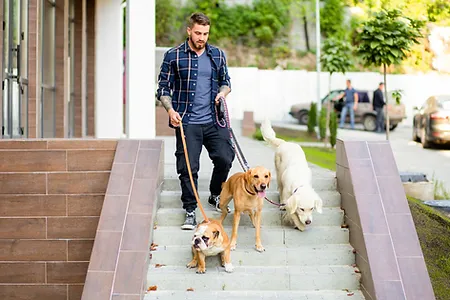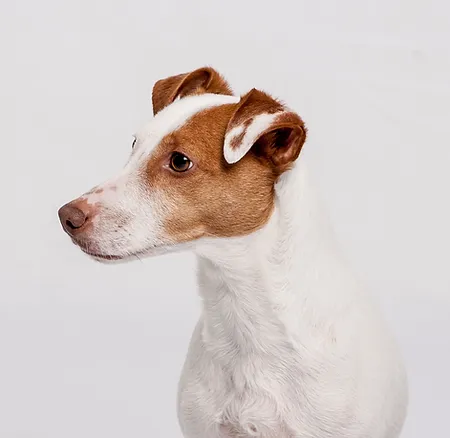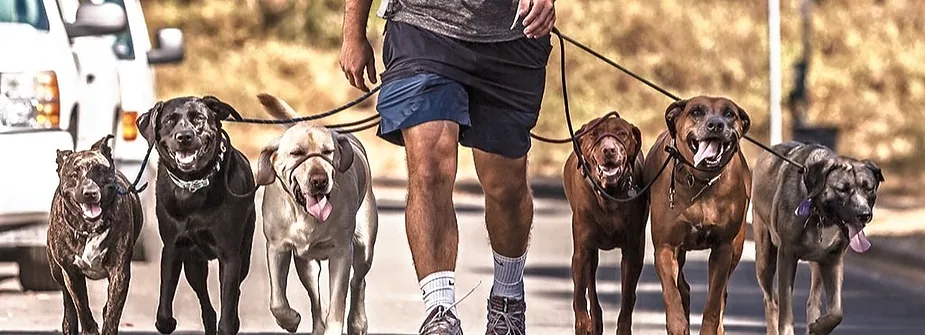
Everybody wants a dog that walks nicely on a leash and is engaged with them. Nothing is worse than getting dragged down the street by your dog, stopping at every bush and tree, and feeling like you have just been put through an upper body workout by the time you get home.
Having this relationship with your dog can be stressful and make taking your dog for a walk feel like a chore. Our dogs don’t pull us down the street because they are trying to give us a RUN for our money (see what I did there… No? Okay, moving on). Training a dog to walk on a leash takes patience, persistence, and repetition. It’s essential to have your dog’s attention and engagement throughout this training for it to be successful!
In this article, I will teach you how to train your dog to walk on a leash and, in turn, allow for more enjoyable walks with your pup.

Step 1: Get Your Dog’s Attention
There are a few simple things that I want you to remember on your next stroll. Rule #1, this is your walk. Rule #2, you are either in the leader or follower position. During your training sessions, stay positive and use a happy/positive tone and body language when communicating with your dog. Dogs respond very well to positivity, making them excited to learn and engage with you!

Step 2: Begin Your Walk with Calm Energy
To begin, ensure that your dog is calm before you walk out the door. No matter how long it takes, have your dog remain in a “sit” while you open the door. This foundational step will help your dog stay calm and focused and help ward off that anxious energy commonly associated with walks. What you do before you start walking sets the tone for how the walk will go! Once your dog is calmly seated with the front door open, start your walk.
The moment your dog forges out ahead of you, make a complete 180 and walk in the opposite direction. Do not look back and wait for your dog to get the memo. Simply turn around and walk the other way. Your dog is going to 1. realize that you turned around on their own or 2. they will hit the end of the leash and have to turn around anyways. These turns help your dog to understand leash pressure and what is expected of them based on that pressure! Leash pressure is the concept of your dog yielding to tension on the leash rather than pulling against the leash through a process called opposition reflex. The more you do this exercise, the more your dog will learn that he will hit the end of the leash if he is not paying attention to you.
After a few repetitions, start layering in the cue “Let’s go!” as soon as you make your 180 turns. With time, you will be conditioning your dog to turn with you when they hear that marker.
Many pet parents unintentionally have enabled their dogs to control their walks. Take, for example, this scenario: you are out for your afternoon walk, you seem to be going at a good pace, and then suddenly, your dog completely stops and turns around to smell a tree. What do you do? I’ve found that most dog owners halt and wait for their dog to finish sniffing. Without them realizing it, their dog has taken control of making decisions such as when to stop, which way to turn, and what pace they are walking! Practicing these 180 turns will help put the decision-making back into your hands.
Building Upon Our Previous “Eye Contact” Lesson:
As a bonus tip, if you have been practicing the break command we discussed in our last lesson, this is the perfect opportunity to start implementing it in the real world. Going forward, I urge you to continue your walk briskly, even if your dog stops for a sniff. Our dogs’ frequent stops often lead us to believe they need to relieve themselves. While that could be possible, if they have already gone, this is likely marking behavior. Remember, you decide how this walk will go!
Now that your dog understands the concept of leash pressure, it will learn to follow you. If they commit to following you even though you can tell they want to stop, reward them with your break command and let them sniff for a minute before carrying on with your “Let’s go!” cue.
Learning how to train your dog to walk on a leash can be time-consuming, but if you follow these simple steps, you will find a dramatic change in your dog’s engagement level and loose leash capabilities.
Additional Resources:


